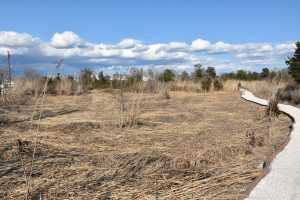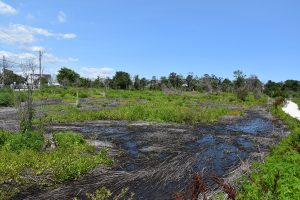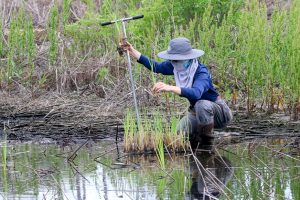by Dr. Lenore Tedesco, Executive Director
 The Stone Harbor Bird Sanctuary is a truly remarkable place, and an important refuge on 7 Mile Island. This 21-acre site boasts a mature Atlantic Maritime Forest and both fresh and tidal wetlands. These forests were once widespread on barrier islands and mainland coasts, but due to coastal development, they now make up less than 1% of the habitat in New Jersey. Their proximity to the sea and the forces that shape them combine to make them unique and special places to explore.
The Stone Harbor Bird Sanctuary is a truly remarkable place, and an important refuge on 7 Mile Island. This 21-acre site boasts a mature Atlantic Maritime Forest and both fresh and tidal wetlands. These forests were once widespread on barrier islands and mainland coasts, but due to coastal development, they now make up less than 1% of the habitat in New Jersey. Their proximity to the sea and the forces that shape them combine to make them unique and special places to explore.
During spring and fall, the Sanctuary is an important migratory stopover for songbirds, dragonflies, and butterflies. Sparrows, robins, thrushes, and woodpeckers make it their winter home. In the summer, the Sanctuary houses dozens of species of nesting songbirds. Black-crowned Night Herons roost on-site, you can find egrets feeding in the tidal marsh, and Ospreys are common sights as they gather sticks and branches to fortify their nests on the back-bay islands. The Sanctuary also provides important habitat for a variety of reptile and amphibian species, and bats can be seen around dusk, particularly during migration.
For several years, The Borough of Stone Harbor and The Wetlands Institute have collaborated to manage the Sanctuary. Over the past 4 years, a major focus has been on the restoration of its tidal and freshwater wetlands. A number of non-native, invasive plants – common reed (Phragmites australis) and purple loosestrife (Lythrum salicaria) in particular – have become established there, crowding out native vegetation and degrading wildlife habitat. In response, the Borough launched the Stone Harbor Bird Sanctuary Habitat Restoration Project to restore native vegetation and wildlife habitat for colonial wading birds, migratory and resident songbirds, tree frogs, and other wildlife that use the Sanctuary.
 Step one was to manage the invasive plants in the wetlands. This was done in the fall of 2021 via application of an herbicide specifically shown to have relatively low toxicity to birds, mammals, and fish. Under permit from NJDEP, licensed professionals treated the invasive plants using a Marsh Master (a low ground-pressure vehicle that can work in marshes) and a hose sprayer or backpack sprayer, depending on the area being treated.
Step one was to manage the invasive plants in the wetlands. This was done in the fall of 2021 via application of an herbicide specifically shown to have relatively low toxicity to birds, mammals, and fish. Under permit from NJDEP, licensed professionals treated the invasive plants using a Marsh Master (a low ground-pressure vehicle that can work in marshes) and a hose sprayer or backpack sprayer, depending on the area being treated.
The initial management was highly successful, leaving tall stands of dead reeds and restoring the marsh water cycle, but the restoration team was concerned about the millions of seeds of the invasive plants still in the marsh soils and sought a way to prevent them from germinating and repopulating the marsh. To tackle this problem, in the spring of 2022 they mulched the dead reed stalks and left them covering the soil for one full growing season to prevent seed germination. In late March of 2023, a small group of restoration ecologists hand-raked and removed a few small patches of mulch to test if the seedbank would sprout during the 2023 growing season. The invasive plants did not return, thus clearing the way for restoration to proceed.
 This spring, restoration experts planted 500 native broad-leaf cattails in the wetter areas of the freshwater marsh. They also spread 20 lbs. of seeds around the 3-acre wetland, including a number of native grasses, flowering plants, pollinator favorites, and plants that provide food and cover for wildlife. This fall, more than 45 native shrubs were planted on the slightly higher hummocks in the marsh.
This spring, restoration experts planted 500 native broad-leaf cattails in the wetter areas of the freshwater marsh. They also spread 20 lbs. of seeds around the 3-acre wetland, including a number of native grasses, flowering plants, pollinator favorites, and plants that provide food and cover for wildlife. This fall, more than 45 native shrubs were planted on the slightly higher hummocks in the marsh.
The effective management of invasive vegetation at the Bird Sanctuary requires a multi-year treatment program. We will continue to monitor the site and adaptively manage as needed, but the goal is to reestablish a self-sustaining ecosystem. These invasive plants will need continual attention: we have eradicated purple loosestrife in the past, but It spreads aggressively via wind-borne seeds and its return has already been documented – likely from backyard gardens. Everyone has a role to play in protecting the Sanctuary and helping its biodiversity thrive. You can do your part by removing purple loosestrife from your own garden.
The Stone Harbor Bird Sanctuary is a special place for plants and animals, and a walk on its trails transports you to another time and place and provides a wonderful respite from the busy days of summer and all year-round. Check the Bird Sanctuary website to learn more.
